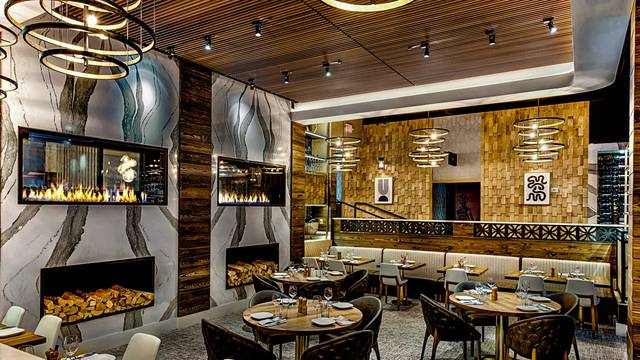Savor Authentic Asian Food With a Pan-Asian Twist for a Culinary Experience
Beginning on a cooking journey via authentic Eastern food, boosted with a Pan-Asian spin, offers a special chance to explore the rich tapestry of tastes that define the area's diverse cooking practices. This experience invites you to appreciate the charming balance of preferences-- wonderful, salted, spicy, and sour-- balanced by fragrant herbs and spices. Envision the ingenious fusion of Thai curry and ramen or the unanticipated joy of sushi burritos. As you contemplate these attracting meals, consider the social narratives and historical impacts that form them, each bite using a tale waiting to be discovered.

Checking Out Pan-Asian Tastes
In the realm of worldwide gastronomy, Pan-Asian cuisine stands apart for its exceptional variety and the harmonious interaction of tastes from numerous Asian cultures. This culinary technique celebrates the abundant traditions and unique components discovered across the continent, producing a tapestry of tastes that is both enjoyable and fascinating. Key to Pan-Asian cuisine is its capability to balance contrasting tastes-- wonderful, salted, spicy, and sour-- while highlighting the freshness and top quality of each component.
From the umami-rich soy sauce of Japan to the fiery chili peppers of Thailand, Pan-Asian food offers a comprehensive combination of flavors. These components are often integrated in innovative methods, improving meals with layers of intricacy. For example, the use of great smelling natural herbs such as lemongrass and cilantro, common in Vietnamese and Thai food, includes a rejuvenating illumination to recipes, while the incorporation of coconut milk delivers a creamy, rich texture.
The emphasis on fresh produce and aromatic flavors makes sure that each meal is not just a banquet for the palate however also for the senses. Pan-Asian food welcomes restaurants to get started on a culinary journey, exploring the large and varied landscapes of Asian gastronomy with every bite.
Combination Dishes to Try
While Pan-Asian food is commemorated for its traditional tastes, the modern culinary landscape is progressively embracing combination recipes that mix these traditional components with influences from various other areas. This innovative technique not only honors the rich heritage of Asian cookeries but additionally introduces unique preference experiences that interest contemporary tastes buds.
An archetype of such a blend recipe is the Korean-Mexican taco, where marinaded bulgogi beef is wrapped in a cozy tortilla, covered with kimchi and a spicy gochujang-infused salsa. This mix weds the vibrant, savory flavors of Korea with the lively, fresh elements of Mexican cuisine. Likewise, sushi burritos have actually obtained popularity, joining together the fragile creativity of Japanese sushi with the passionate, hand-held convenience of a burrito, typically featuring combination active ingredients like tempura shrimp and avocado with a drizzle of wasabi mayo.
An additional notable dish is Thai curry ramen, which infuses the velvety, aromatic flavors of Thai curry into the reassuring broth of conventional Japanese ramen, developing an unified blend that entices the detects. These blend meals extend beyond mere novelty; they represent a culinary discussion between societies, encouraging exploration and technology on the planet of Pan-Asian food.
Essential Components and Spices
To really value Pan-Asian food, one need to comprehend the necessary components and spices that form its foundation. This diverse cooking style attracts from an abundant tapestry of Oriental traditions, utilizing a harmonious mix of appearances and flavors.
Fragrant aspects are essential, with garlic, ginger, and lemongrass being common throughout various Pan-Asian dishes. These active ingredients supply a fragrant base that improves the intricacy of flavors. Spices such as celebrity anise, cardamom, and cinnamon introduce heat and character, echoing impacts from areas like China and India.

Food Preparation Strategies and Tips
Mastering the art of Pan-Asian food calls for knowledge with its distinctive food preparation methods, each contributing to the dynamic tapestry of flavors this culinary custom is celebrated for. Central to these dhaba approaches is the stir-fry, a fast cooking technique that preserves the nutritional honesty and brilliant colors of ingredients. Making use of a frying pan, the stir-fry approach enables even warm circulation, essential for attaining the particular appearance and flavor equilibrium of Pan-Asian dishes.
One more fundamental technique is steaming, particularly common in Chinese food. This gentle approach preserves the natural tastes and nutrients of ingredients, making it excellent for fish and shellfish and veggies. Dumplings, a precious staple, typically benefit from steaming, causing soft, succulent appearances.
Cooking, additionally indispensable, imparts smoky depths to recipes such as Oriental bulgogi or Japanese yakitori (Chinese food Islamabad). This technique commonly includes marinating ingredients, permitting tastes to penetrate deeply before cooking over an open flame or hot plate
Finally, grasping the art of stabilizing tastes-- sweet, sour, salty, bitter, and umami-- is crucial. Effectively layering these elements can raise a dish from regular to amazing, providing a facility and satisfying cooking experience that embodies the significance of Pan-Asian cuisine.
Dining Experiences Worldwide
Throughout the world, Pan-Asian food provides an unrivaled dining experience, commemorated for its rich tapestry of tastes and dynamic presentations. This cooking phenomenon has transcended cultural limits, recording the hearts and tastes buds of food lovers worldwide. In cosmopolitan cities fresh York, see here now London, and Sydney, Pan-Asian restaurants function as melting pots where culinary customs from Thailand, Japan, China, and beyond converge, supplying diners with an eclectic mix of dishes that highlight the area's diversity.
The global charm of Pan-Asian cuisine depends on its capability to provide both authenticity and advancement. Cooks masterfully marry standard ingredients such as lemongrass, soy sauce, and miso with modern techniques, causing meals that are both refreshingly new and acquainted. This combination enables diners to start a cooking trip that respects heritage while welcoming modernity.
Moreover, eating experiences are raised with thoughtfully designed settings that show the ethos of Pan-Asian appearances. From minimal Japanese-inspired interiors to dynamic Thai-themed spaces, each restaurant provides an one-of-a-kind ambiance that enhances the cooking offerings. Because of this, patrons are not just taking in a meal however partaking in a cultural experience, making Pan-Asian eating a truly international phenomenon.
Verdict
The expedition of Pan-Asian food offers an extensive understanding of the elaborate interaction of tastes and cooking traditions throughout Asia. By accepting fusion dishes such as Thai curry ramen and sushi burritos, the cooking trip not only highlights the flexibility of typical ingredients however also showcases cutting-edge modern methods. This gastronomic adventure, enriched by cooking methods and necessary flavors, supplies an unique opportunity to value the multiculturalism and cooking artistry that define Pan-Asian cuisine on a worldwide range.
Beginning on a cooking trip via authentic Eastern cuisine, boosted with a Pan-Asian twist, supplies a distinct chance to discover the rich tapestry of flavors that specify the region's diverse culinary practices.In the realm of global gastronomy, Pan-Asian food stands out for its amazing variety and the harmonious interaction of tastes from various Asian societies. Trick to Pan-Asian cuisine is its capacity to balance different tastes-- sweet, salty, spicy, and sour-- while highlighting the quality and quality of each component.
